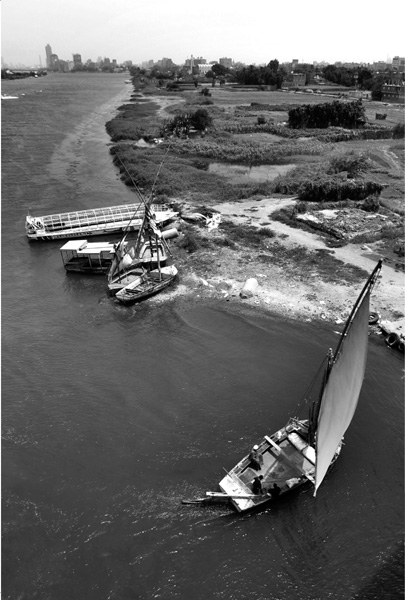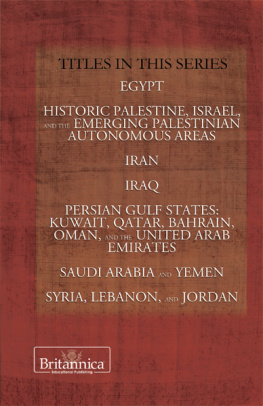EGYPT
MIDDLE EAST
REGION IN TRANSITION
EGYPT
EDITED BY LAURA S. ETHEREDGE, ASSOCIATE EDITOR, MIDDLE EAST GEOGRAPHY

Published in 2011 by Britannica Educational Publishing
(a trademark of Encyclopdia Britannica, Inc.)
in association with Rosen Educational Services, LLC
29 East 21st Street, New York, NY 10010.
Copyright 2011 Encyclopdia Britannica, Inc. Britannica, Encyclopdia Britannica,
and the Thistle logo are registered trademarks of Encyclopdia Britannica, Inc. All
rights reserved.
Rosen Educational Services materials copyright 2011 Rosen Educational Services, LLC.
All rights reserved.
Distributed exclusively by Rosen Educational Services.
For a listing of additional Britannica Educational Publishing titles, call toll free (800) 237-9932.
First Edition
Britannica Educational Publishing
Michael I. Levy: Executive Editor
J.E. Luebering: Senior Manager
Marilyn L. Barton: Senior Coordinator, Production Control
Steven Bosco: Director, Editorial Technologies
Lisa S. Braucher: Senior Producer and Data Editor
Yvette Charboneau: Senior Copy Editor
Kathy Nakamura: Manager, Media Acquisition
Laura Etheredge: Associate Editor, Middle East Geography
Rosen Educational Services
Hope Lourie Killcoyne: Senior Editor and Project Manager
Nelson S: Art Director
Cindy Reiman: Photography Manager
Nicole Russo: Designer
Matthew Cauli: Cover Design
Introduction by Laura Etheredge
Library of Congress Cataloging-in-Publication Data
Egypt / edited by Laura S. Etheredge.
p. cm. (Middle East : region in transition)
In association with Britannica Educational Publishing, Rosen Educational Services.
Includes bibliographical references and index.
ISBN 978-1-61530-392-2 (eBook)
1. Egypt. 2. EgyptHistory. 3. EgyptPolitics and government.
4. EgyptSocial conditions. 5. Social changeEgyptHistory. I. Etheredge, Laura.
DT46.E318 2011
962dc22
2010025194
On the cover (clockwise from top left): A view of Cairos skyline, featuring the 14th century Sultan Hassan Mosque; a camel caravan crosses before the pyramids of Giza; the dramatic Bibliotheca Alexandrina, inaugurated in 2002, sits near the site of the near-mythic Library of Alexandria, believed to have been destroyed nearly two millennia ago; in this copy of a painting from Queen Nefertaris tomb in Thebes, she is shown making an offering to Isis, one of the most important goddesses of ancient Egypt. www.istockphoto.com/ TriggerPhoto; Shutterstock.com; Mohamad Al Sehety/AFP/Getty Images; Shutterstock.com
On pages : Cars drive on a bridge crossing the Nile on Feb. 9, 2006, in Central Cairo, Egypt. Marco Di Lauro/Getty Images
CONTENTS









INTRODUCTION

Egyptian sailboats known as feluccas, seen here on the outskirts of Cairo, are used to ferry passengers from one side of the Nile River to the other (May 2010). Khaled Desouki/AFP/Getty Images
T he ancient Greek historian Herodotus called Egypt the gift of the Nile. Indeed, where the Nile bisects Egypt it is bordered by land of extraordinary fertility, terrain set apart in sharp relief from the aridity that marks much of the country. As this book details, the legendary generosity of the Nile provided for a large agrarian population given to the cultivation of the land, and Egypt became one of the major food producers of the region. Ideas and their exchange also flourished there, and Egypt gave rise to one of the worlds earliest urban, literate societies. Readers of this comprehensive volume will learn how under a succession of local and foreign dynasties, Egypt thrived under pharaonic rule for three millennia and, with its conquest by Alexander the Great in 323 BCE, Egypt was ushered into the Hellenic world. After being taken by the Romans nearly 300 years later, it was absorbed first into that empire and subsequently into the Byzantine Empire, the successor to the Romans, before the arrival of Arab forces in the mid-7th century.
The most famous of Egypts physical features is the Nile River. The worlds longest river, the Nile dominates the topography of the country. The river runs northward on its course and, near Cairo, it begins to fan out into its delta. The Nile and its delta, along with the Western and Eastern deserts and the Sinai Peninsula, form Egypts four major geographic regions. In a country that is mainly desert, the Eastern and Western deserts comprise some one-fourth and two-thirds of the country respectively. By contrast, both the Nile valley and Nile delta are under perennial irrigation, and agriculture is important there. In the northeast, the wedge-shaped Sinai Peninsula is lined by the Mediterranean Sea and the gulfs of Suez and Aqaba; in the Sinais mountainous south lies Mount Catherine, Egypts highest point. Egypts climate consists of what are effectively two seasons: a cool, mild winter and a hot summer, with short transitional periods in between. Precipitation levels, low overall, decrease farther southward.
Egyptians living in the Nile valley and delta are generally an ethnically homogeneous blend of African and Arab elements. Nubians, in the extreme south of the country, differ in ethnicity and culture from other Egyptians and share similarities with groups in sub-Saharan Africa. Nomadic, semi-nomadic, and sedentary but once nomadic groups live in parts of the Sinai and in the countrys deserts. Some form of Arabicthe countrys official languageis spoken by most Egyptians, and the country is largely Sunni Muslim. The Christian minority is dominated by the Coptic denomination, whose community in Egypt predates the 7th century arrival of Islam. Much of Egypts population is concentrated along the banks of the Nile, where the population density is among the worlds highest. More than two-fifths of Egyptians live in cities, including Cairo, the capital and largest city. The population, generally young overall, is also increasing rapidly; efforts have been made since the 1960s to restrain the high birth rate.
Challenges facing the Egyptian economy include not only a rapidly growing population but finite land with which to support its citizens. Chronic underemployment has sent many Egyptians in search of jobs abroad. Arable land is an important resource, and although most of the country is desert, agricultural pursuits still employ some one-fourth of the population on a measure of arable land equivalent to only 3 percent of the countrys area. Other resources include petroleum, although Egyptian production is low by regional standards, and significant natural gas deposits are known. The Nile offers enormous hydroelectric potential, although the majority of Egyptian power is produced by thermal means. Manufacturing increased dramatically in the 20th century, and the country produces chemicals, textiles, and other items. Raw materials, machinery, and chemical products, as well as foodstuffs, account for a significant proportion of Egyptian imports.
Next page

























